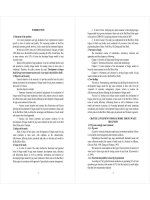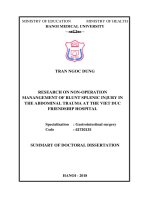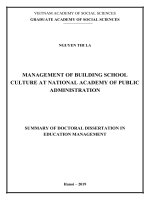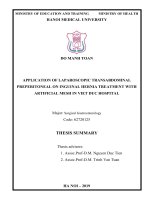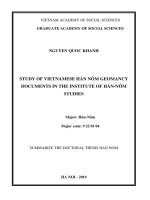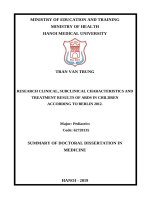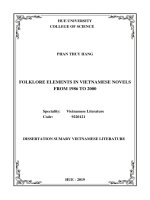Nghiên cứu văn bản then cấp sắc nôm tày tại viện nghiên cứu hán nôm tt tiếng anh
Bạn đang xem bản rút gọn của tài liệu. Xem và tải ngay bản đầy đủ của tài liệu tại đây (848.26 KB, 27 trang )
VIETNAM ACADEMY OF SOCIAL SCIENCES
GRADUATE ACADEMY OF SOCIAL SCIENCES
NGUYEN VAN TUAN
RESEARCHING THE THEN CẤP SẮC
DOCUMENTS STORED AT INSTITUTE OF
HAN NOM STUDIES
Specialization: Han-Nom
Code: 9 22 01 04
THE SUMMARY OF DOCTORAL THESIS IN SINO-NOM
HA NOI - 2019
The dissertation completed at Graduate Academy of Social Sciences,
Vietnam Academy of Social Sciences
Supervisor: Prof. PhD Nguyen Ta Nhi.
Reviewer 1: Associate Prof. PhD Đinh Khac Thuan
Reviewer 2: Associate Prof. PhD Ha Van Minh
Reviewer 3: PhD. Trinh Ngoc Anh
The dissertation will be defended at Graduate Academy Level
Council of dissertation assessment at Graduate Academy of Social
Sciences
Time: ………… date ………. month …… …year 2019
The dissertation may be found at:
-
Vietnam National Library;
Graduate Academy of Social Sciences Library
INTRODUCTION
1. Rationale
In addition to a large population, Tay ethnic minority also have a rich
heritage of unique cultural materials preserved until today which contains
poems and tales, luon coi, phong slu and Then singing. These materials are
usually documented in Nom script of Tay people (Tay Nom) and among
which, we pay special attention to “Then cấp sắc” documents. The study of
Then cấp sắc documents recorded in Nom script not only help to clarify
contents of such documents, but also contribute to preserving and promoting
values of local culture.
The Institute of Han Nom Studies currently stores a total of 06 Tay
Nom written documents of Then cấp sắc. Although the quantity is not
significant, the available documents can provide an overall picture of Then
cấp sắc Tay once surveyed and studied.
For the above-mentioned reasons, we select "Researching the Then
cấp sắc documents stored at The Institute of Han Nom Studies" as the
topic for doctoral thesis in Han Nom.
2. Purpose and objective
2.1. Purpose
The results of this study contributes to the introduction, conservation
and promotion of Then cấp sắc documents written in Tay Nom in particular
and Tay Nom texts in general.
2.2. Objective
Based on the established research purpose, we accordingly set
objectives for the thesis as follows:
- Systematize Then cấp sắc documents currently stored at the
Institute.
1
- Study the characteristics and structure of texts, Nom scripts;
determine the number of chapters and songs in the documents based on
which define the concept of "Đường Then" and "đường then cấp sắc"
recorded in Then cấp sắc documents.
- Present values of Then cấp sắc documents in ancient-time Tay
culture, thereby propose measures to preserve and promote which values in
contemporary cultural life.
3. Object and scope of research
3.1. Research object
This thesis studies a group of 6 Then cấp sắc documents written in
Tay Nom and currently stored at the institute coded: NVB.1; VNv.671;
NC.50; ST.2227; ST.2201; ST557. These are documents that have never
been translated and published.
3.2. Scope of research
This study focuses on textual issues of Then cấp sắc documents, the
issue of using Nom in texts, the concept of " đường then cấp sắc" and values
of Then cấp sắc contents in the cultural and religious life of Tay people.
4. Research methodology and methods of research
4.1. Research methodology
Knowledge of Han Nom Literature, textual studies, cultural studies,
studies of ancient documents and interdisciplinary research will be applied
in each chapter of the thesis.
4.2. Methods of research
This study employs the following methods of research:
- Textual studies.
- Hermeneutics.
- Ancient documents studies.
- Quanlitative method.
2
- Interdisciplinary method.
5. Contribution
- Introduce and analyze the concept of Then and Then cấp sắc in a
broad and narrow sense.
- Introduce characteristics of Then cấp sắc documents of Tay people;
identify reliable documents for research and introduction.
- Provide reliable data on the number of song and song chapters in
Tay Nom written Then cấp sắc documents of three main branches of Then
in three provinces of Cao Bang, Bac Kan and Lang Son.
- Use analysis and evaluation to demonstrate content and art values
of Then cấp sắc documents.
- Provide phonetic transcription, translation, annotation and
introduction of Tay Nom written Then cấp sắc documents.
6. Significance
- Studying and analyzing documents; identifying reliable sources for
translation, introduction and publishing of Then cấp sắc documents;
studying Nom scripts in selected documents, contributing to the study of
Nom script system of Tay people.
- Present an overall picture of “đường then cấp sắc”of Tay people,
including: the journey of Then travelling from the mortal world to heaven to
meet the Jade Emperor (king of heaven), the number of chapters and songs
recorded in Tay Nom written Then cấp sắc documents stored at the
Institute.
- The thesis paves the way for further studies of Then cấp sắc
documents in particular and ritual folk songs of Tay people in general.
Hopefully, this thesis will contribute to the preservation, research and
promotion of cultural values of Tay people.
3
Chapter 1
AN OVERVIEW OF RESEACH
1.1. Overview of Tay people and their Then and Then cấp sắc
1.1.1. Tay people and their culture
Among ethnic groups in Vietnam, Tay has the second largest
population, coming after Kinh‟s. Tay people mainly resides in mountainous
areas to the North of the country and provinces in Central Highlands such as
Dak Lak and Lam Dong.
In terms of historical origins, Tay ethnic "belongs to the same group
of Au Viet within the Bach Viet bloc whose residence set in Northern
Vietnam and Southern States of China”.
In terms of language and writing, Tay language belongs to the Tay Thai language group (Thai - Ka Dai language family) which is widely used
in communication.
In terms of production activities, Tay people are farmers of rice
agriculture who have been able to cultivate farmland and use irrigational
system since the early days.
Regarding traditional customs and beliefs, Tay people have plenty of
distinguished customs that express their own unique culture such as: Family
acceptance, child adoption, “ket tong ket dam” and weddings.
Regarding folk religion, Tay people are polytheists.
1.1.2. Then and Then cấp sắc
1.1.2.1. Fundamental concepts
* Concepts of “Then” and “Then cấp sắc”
Based on findings of predecessor researchers, the concept of "Then"
is understood in broad and narrow sense. In narrow sense, "Then" is the
name of a form of worship that originates from the worship of heaven (pha)
of Tay and Thai residents in and is generally referred to as Then, Put
4
religion (as explained by Nguyen Thi Yen). In broad sense, "Then" is the
name of a specific aspect related to Then religion.
Regarding the concept of "Then cấp sắc", Nguyen Thi Yen stated "It
is a ceremony to recognize a Then master's practice status which belongs to
great ceremony category of Then with a larger organization scope and links
to the worship of Then‟s forefather. Thus, "Then cấp sắc" is the name of a
Then ritual, an extended concept deriving from the broad concept of "Then"
which indicates a form of religious activities of Tay people.
* Concepts of “Then documents” and “Then cấp sắc documents”
Accordingly, "Then documents" in general and "Then cấp sắc
documents " in particular may include documents written in ancient Tay
Nom and texts written in Latin language that are transcribed from Tay Nom
or recorded by field voice recording and videoing.
That being said, we limit Then cấp sắc documents used in this thesis
to lyrics of Then cấp sắc songs written in Tay Nom which are studied from
textual studies perspective. Other forms of art (music, performance, etc) are
not applicable in this case.
1.1.2.2. Origin of Then, Then masters and rituals system
- Origin of Then: From our viewpoint, nowadays‟ Then Tay was
born in a period of developed Vietnamese feudalism when, in Tay‟s society,
there were distinct class divisions and intellects of Confucianism plus,
cultural exchange with that of other ethnic groups.
- Then masters: All Then masters are capable of using dan tinh. Their
mission is to practice worship rituals that convey messages of the mortal
world to the gods through playing musical instruments and singing.
- Rituals system: According to our initial survey over Then
documents written in Tay Nom, there are only typical rituals divided into 3
basic types by Trinh Khac Manh: 1 /Blessing Then used in rituals such as
5
new year, house building and prosperous business; 2/ Then that prays for
peace and relieves one‟s run of bad luck including peace praying and bad
luck relief; 3/ Festive Then is used in ceremonies such as seasonal farming
praying and “cấp sắc”.
1.1.2.3. Overview of cấp sắc ceremony
- Purpose of a cấp sắc ceremony: This is a ceremony that recognizes
that apprentices become official Then masters and qualified professionals.
- Location of a ceremony: A cấp sắc ceremony is performed at the
apprentice‟s home.
- Duration and details of a ceremony: Duration of a ceremony
depends on the host family's economic capacity and normally extends four
days and three nights.
1.2. Overview of existing collection and study related to the
thesis’s topic
1.2.1. Research works from the perspective of cultural beliefs
1.2.1.1. The research works from the perspective of cultural
beliefs about Then
1.2.1.2. The research works from the perspective of Then
Grant excellent cultural beliefs
1.2.2. Research works from an art culture perspective
1.2.2.1. Research works from the perspective of art culture on
Then
1.2.2.2. The research works from the perspective of art and
cultural aspects of Then level
1.2.3. Collection and introduction of Then documents
1.2.3.1. The collection and introduction of Then song lyrics
1.2.3.2. The collection and introduction text of Then grant
excellent singing
6
1.2.4. Overview of relevant studies
Due to different research circumstances and purposes, most of the
studies only manage to scope out, with little content analysis of specific Tay
Nom documents. Especially for Then cấp sắc, we have not seen any
projects that use Tay Nom written Then cấp sắc documents to execute a
systematically comprehensive research.
1.3. Orientation of research
- Conduct a comprehensive research and surveying of 06 Then cấp
sắc documents available at the Institute.
- Study “đường Then” in Then cấp sắc documents to determine the
concept of “đường Then” và “Then cấp sắc” and the journey of “đường
Then cấp sắc” that written in the Then cấp sắc documents.
- Study Nom scripts recorded in Then cấp sắc documents and draw
judgements about characteristics of Nom scripts in Then cấp sắc documents.
- Study characteristics of Tay Nom written Then cấp sắc
documents, and indicate the most typical characteristics of the texts.
- Study values of Then cấp sắc documents in terms of contents and
art, make recommendations on conservation and promotion of Then cấp sắc
documents to introduce about ritual folk songs of Tay people in general
Vietnamese culture.
Summary of Chapter 1
In this chapter, we have generalized some fundamentals about Tay
ethnic and their culture and also provided an overview of Then and Then
cấp sắc of Tay people.
7
Chapter 2
SURVEYING TAY NOM WRITTEN THEN CẤP SẮC DOCUMENT
AVAILABLE AT THE INSTITUTE OF HAN-NOM STUDIES
2.1. Description of Tay Nom written Then cấp sắc documents
2.1.1. Cấp sắc-related documents
The term "cấp sắc-related documents" is used because not the entire
of documents but only some parts of them were used by Tao masters and
Then masters based on actual work required in the ceremonies.
2.1.2. Tay Nom written Then cấp sắc documents
Surveying Tay Nom written Then cấp sắc document stored in the
institute, we find that there are 6 documents. Some of which are fully intact
and some were damaged with first few pages missing.
2.2. Study characteristics of Then cấp sắc documents
2.2.1. Form of documents
2.2.1.1. Origins of documents
Among 06 available documents, we find that there are 04 of which
originating from Lang Son, 01 from Bac Kan and 01 from Cao Bang.
2.2.1.2. Names of documents
Among 06 available documents, 04 of which specify name of the
document (or title) and there are 4 documents that have 04 different names
despite their identical contents.
2.2.1.3. Dating of documents
All 06 surveyed documents were copied in the early twentieth
century. These documents were copied from older documents that
underwent several copying, therefore preserved many cultural and literary
charactertistics of previous centuries.
2.2.1.4. Copier
8
It is impossible to identify the copiers of 02 documents because of
some missing first pages. The remaining 4 documents present full name of
the copiers. In terms of social status and career of the 04 identified copiers, it
can be affirmed that they must have been Confucianists, educated people
and possibly Then masters in Tay society.
2.2.1.5. Literary genres
In 06 surveyed documents, the poetry form of 5-word lines are the
most popular, followed by 9-word line poems and prose.
2.2.2. Structure of documents
2.2.2.1. Song chapters
Statistically, there are 27 chapters in NVB.1; 13 chapters in ST.2227;
20 chapters in ST.2201; 16 chapters in ST.557; 22 chapters in VNv.671; and
17 chapters in NC.50. From conducted comprisions, we conclude
similarities and differences in name of documents‟ chapters are attributable
to different branches of Then.
2.2.2.2. Content layout of documents
We find that all 06 documents have clear content layout with 03 parts
as follows:
- Part one: The contents mainly involves preparation for a trip.
- Part two: Then army's troops began to depart from the mortal world
until they reached the Emperor‟s door and asked for “cap sac”.
- Part three: Then army troops safely returned from the heaven to the
mortal world.
2.2.2.3. Reliable documents for research
Based on the survey results, we have decided to select the NVB.1 as
the reliable version for the Then branch in Lang Son; the VNv.671 for the
Bac Kan branch; and NC.50 for Cao Bang branch as the objects for Tay
Nom written Then cấp sắc documents study.
9
2.3. Issues regarding Nom writing recorded in Then cấp sắc
documents
2.3.1. Study of Tay Nom
Due to the fact that many researchers have conducted studies on Tay
Nom from many different angles, the author of this thesis is not going into
details about structure of Tay Nom writing but researching in a statistical
perspective, classifying the amount of Nom writing in particular Tay Nom
written Then cấp sắc documents.
2.3.2. Classification of Tay Nom in Then cấp sắc documents
2.3.2.1. Total up, classify Nom writing in the documents
Our review over 06 Then cấp sắc documents reveals a record of
216.746 uses of Nom writing in total, including 52.397 uses of native Tay
Nom writing (accounting for 24.2%), 106.291 uses of borrowed Nom
writing from the Kinh‟s version of Nom (accounting for 49%) and 58.058
uses of borrowed Nom writing from the Chinese version of Nom
(accounting for 26.8%).
Regarding the number of Nom characters in 6 documents, there are a
total of 27,412 characters. Among them, 9,111 characters are native Tay
Nom (accounting for 33.2%), 10,003 characters are borrowed from Kinh‟s
version (accounting for 36.5%), and 8,298 characters are borrowed from the
Chinese version (accounting for 30.3%).
2.3.2.2. Classification of Tay Nom characters borrowed from the
Chinese version
- Borrowed character, sound and meaning: 476 characters found in
NVB.1 (accounting for 35,1%); 558 found in VNv.671 (accounting for
28,4%); 307 found in NC.50 (accounting for 31,0%).
10
- Borrowed character and sound: 238 characters found in NVB.1
(accounting for 17,6%); 424 found in VNv.671 (accounting for 21,6%); 210
found in NC.50 (accounting 20,3%).
- Borrowed character and meaning: 65 characters found in NVB.1
(accounting for 4,8%); 96 found in VNv.671 (accounting for 4,9%); 54
found in NC.50 (accounting for 5,4%).
- Borrowed character and meaning with Han-Viet pronunciation:
127 characters found in NVB.1 (accounting for 9,4%); 244 found in
VNv.671 (accounting for 12,4%); 115 found in NC.50 (accounting for
11,6%).
- Borrowed character with Han-Viet pronunciation: 251 characters
found in NVB.1 (accounting for 18,5%); 344 found in VNv.671
(accounting for 17,5%); 170 found in NC.50 (accounting for 17,2%).
- Borrrowed character only: 198 characters found in NVB.1
(accounting for 14,6%); 299 found in VNv.671 (accounting for 15,2%); 144
found in NC.50 (accounting for 14,5%).
In conclusion, based on our research, the document in Lang Son has
total 1.355 Sino characters with frequence of 12.548 appearances; the
document in Cao Bang has total of 991 Sino characters with frequence of
10.910 appearances; the document in Bac Kan has total 1.956 Sino
characters with frequence of 13.426 appearances.
2.3.2.3. Classification of Tay Nom scripts that borrowing from
Kinh Nom.
- Borrowed character, sound and meaning. NVB.1 version found
2,248 characters (accounting for 80.7%); VNv.671 version found 1,774
characters (accounting for 83.1%); NC.50 version found 1,191 characters
(accounting for 79.8%).
11
- Borrowed character, meaning, read slightly different. NVB.1
version found 398 characters (accounting for 14.3%); VNv.671 version
found 303 characters (accounting for 14.2%); NC.50 version found 164
characters (accounting for 11.0%).
- Borrowed character, meaning, not borrow sounds. NVB.1
version found 139 characters (accounting for 5.0%); VNv.671
version found 58 characters (accounting for 2.7%); NC.50 version
found 137 characters (accounting for 9.2%).
In term of frequency of appearances of words that borrowed from
Kinh Nom, we found that the document in Lang Son has total of 2.786
characters with frequence of 27.546 appearances; the document in Cao
Bang has total of 1.493 characters with frequence of 16.436 appearances;
the document in Bac Kan has total 2.135 characters with frequence of
18.196 appearances.
2.3.2.4. Classification of self- developed Tay Nom scripts
- The coordinated sysphograph: NVB.1 version found 201
characters (accounting for 7.5%); VNv.671 version found 58
characters (accounting for 5.3%); NC.50 version found 68 characters
(accounting for 5.0%).
- The principal and accessory sysphograph: NVB.1 version
found 99 characters (accounting for 3.7%); VNv.671 version found
36 characters (accounting for 3.3%); NC.50 version found 50
characters (accounting for 3.7%).
- The coordinated syssematograph: NVB.1 version found 345
characters (accounting for 12.9%); VNv.671 version appears 129
characters (accounting for 11.9%); NC.50 version appears 269
characters (accounting for 19.8%).
12
- The coordinated phonogpram: NVB.1 version found 797
characters (accounting for 29.8%); VNv.671 version found 311 characters
(accounting for 28.6%); NC.50 version found 386 characters (accounting
for 28.4%).
- The principal and accessory phonogram: NVB.1 version
found 1,089 characters (accounting for 40.7%); VNv.671 version
found 523 characters (accounting for 28.1%); NC.50 version found
542 characters (accounting for 39.9%).
- Single characters that borrow sounds: NVB.1 version found 104
words (3.9%); VNv.671 version appears 23 characters (2.1%); NC.50
version found 29 words (2.1%).
- Single characters that borrow meaning: NVB.1 version appears 40
characters (accounting for 1.5%); VNv.671 version found 8 characters
(accounting for 0.7%); NC.50 version found 15 characters (1.1%).
When classifying the self-created Tay Nom scripts, we found out that
the document in Lang Son has total of 2.675 characters with frequence of
10.023 appearances; the document in Bac Kan has total of 1.087 characters
with frequence 9.579 appearances; the document in Cao Bang has total of
1.358 words with frequence 9.179 appearances.
2.3.3. Characteristics of Tay Nom script in the Then cấp sắc document
2.3.3.1. Use many borrowed scripts
Then cấp sắc documents used many borrowed scripts, first were
from of Kinh Nom, then Sino and lastly were self-created ones (NVB.1 the
borrowed Kinh Nom script has 2,786 characters, the frequency of 27,546
appearances, the proportion is 55%; borrowed Sino has 1,355 characters, the
frequency of occurrence is 12,548, the proportion is 25 %, self-created
characters have 2,675 literal units, frequency appears 10,023 turns, rate of
turns accounts for 20%).
13
2.3.3.2. Using Nom characters that have multiple ways of writing
In Then cấp sắc documents, there were quite a lot of characters that
have two ways of writing. In fact, these are both “simplifying” and
“combining” between the way of writing the borrowed and self-created
characters.
Summary of chapter 2
In this chapter, we have described 5 documents related to cấp sắc
written in Sino and Tay Nom and 6 Then cấp sắc documents written in Tay
Nom which currently stored in Institute of Han Nom Studies.
The chapter has solved the problems of text structure, the issue of the
best version, the problem of Tay Nom script written in 6 Then cấp sắc
documents.
Chapter 3
STUDYING THE “ĐƯỜNG THEN” IN TAY NOM WRITTEN
THEN CẤP SẮC DOCUMENTS
3.1. Some basic issues regarding “đường then” and “đường then
cấp sắc”
3.1.1. The concepts of “đường then” and “đường then cấp sắc”
3.1.1.1. “Đường then” concept
In short, in a broad sense, we can understand that “Đường then” is a
general artistic space consisting of many elements (lyrics, music, dance,
etc.) in combination with each other to, in sequences in a Then ceremory.
However, in a narrow sense of the text, “Đường then” can be unserstood as
the sequences of the lyrics that written in the Then documents. As the
14
research objective of this thesis is Then cấp sắc documents, we will refer to
the narrow sense of understanding.
3.1.1.2. “Đường then cấp sắc” concept
From the understanding of “Đường then” concept as above, the
“Đường then cấp sắc” that we determined to study in this thesis is: the order
of lyris in sequences, describing the journey of Then master with the ghost
sodiers, to bring the offerings to Heaven to pay tributes to the Jade Emperor
for the certificate approval, which written in Tay Nom documents.
3.1.2. The rules used to grant certificate for Then
3.1.2.1. Regulations on naming the religious title.
To name the religious title for Then master, it needed to based on the
Sexagenary circle in Thần tiêu ngọc cách công văn to grant. It means, based
on each age that has different “Kanshi” (Giap Ty, At Suu, Binh Dan,…),
there would have different religious names.
3.1.2.2. Regulations on naming the fate seal
To name the Then‟s fate seal, it was also based on the Sexagenary
circle in Thần tiêu ngọc cách công văn. This seal was always raised by Then
in the glutinous rice bowl to help the Then.
3.1.2.3. Regulations on granting the sodiers
To grant the soldier, Thần tiêu ngọc cách công văn determined based
on the “Shi” (Ty, Suu, Dan, Mao,…).
3.1.3. Some of the first “calling upon” songs in a cấp sắc ceremory.
3.1.3.1. Calling upon the Budda, the Jade Emperor and the Divine
Generals
Since it‟s needed to go to the Jade Emperor‟s gate to ask for the
granting of the certificate, the Then master, before the journey, must call
upon the Saints to witness and help them succeed.
3.1.3.2. Calling upon local gods
15
Local gods are the tutelary gods, God of the Local Land, Kitchen
God and ancestors. These gods are both local gods (where Mr. / Mrs. Then
resides) and local spirits of the landlord in the ceremony. Compared to the
Divine Generals and the Then‟s ancestors, the role of local gods is more
modest.
3.1.3.3. Calling upon the Ancestors and Lineage of the Then
According to Then‟s concept, the Ancestor hold all Then magics.
Therefore, the Then masters must bring offerings and call upon them to ask
for magics.
3.2. Understandring “đường then” in Tay Nom Then cấp sắc
documents.
In order to understand “đường then cấp sắc” in documents, we based
on the actual source of the data written in the document. Here, we took the
NVB.1 version (belonging to Lang Son); VNv.671 (in Bac Kan); NC.50
(Cao Bang) to study for this chapter.
3.2.1. Statistics and comparison of songs in Then cấp sắc documents
3.2.1.1. Criteria for text statistics
Firstly, all chapters in 3 documents will be listed by name on each
sheet of each specific document.
Secondly, the task is to fully inventory the number of songs in 3 Then
cấp sắc documents.
Thirdly, the issue of classifying songs is a very important and
necessary task for the classification of text layouts.
3.2.1.2. Results of the statistics and comparison of chapters and
songs in the documents.
Through the review, we could see the following results: the NVB.1
version has 27 chapters with 57 songs and 145 rhythms; VNv.671 version
16
has 22 chapters with 36 songs and 40 rhythms; NC.50 version has 17
chapters with 39 songs and 40 rhythms.
In terms of songs with same content, there is 9,1% in NVB.1 version,
7,6% in VNv.671 version and 7,6% in NC.50 version.
3.2.2. The order of songs in Then cấp sắc documents
3.2.1.1. About the sequence of songs
From the review results, our comments are “đường Then cấp sắc”
was developed in different lines, so the sequence of songs depended on each
line. Especially, in the process of transmission, Then has been supplemented
by generations. Therefore, the order of the songs will not stop at the number
of 12, or 14, or 35, etc., but it will grow even more, as in the results shown in
Then cấp sắc written in Tay Nom script.
3.2.1.2. About the Then gates expressed in the songs
We conducted a survey of the contents of the songs, and all three
texts were mentioned, which mentioned 12 gates on the journey to heaven.
However, there are differences in the way of the 12-door journey in the
three documents. This further demonstrates that among the key lines there
are separate rules for each line.
3.2.1.3. About the literature styles of the songs.
- Reprorting style
- Describing style
- Telling style
- Dialogueing style
3.2.3. The contents of songs in Then cấp sắc documents
3.2.3.1. Preparation for a journey
The first songs were about the offerings for Ngoc Hoang, then the
arrangement of soldiers and sacrifices to inform the ancestors of the purpose
17
of organizing the journey, etc., were the stages of the preparation for a trip to
heaven.
3.2.3.2. On the journey
In this topic, the songs are about the journey to the Heaven‟s upper
part of the Then army. After being granted the certification for being Then
by the Jade Emperor, the Then together with the army returned to the earth.
3.2.3.3. End of the journey
After returning to the earth, the Then army troops gladly
congratulated the new Then, from now on, they would have the power to
save such humanity with high reputation, full of happiness and prosperity,
and being served everyday.
3.3. Characteristics of “đường then” Tay Nom Then cấp sắc
documents
3.3.1. Characteristics of form
“Đường then” in Then cấp sắc has the most songs in the general
Then system. In addition, in the text, there is always has a chapter named
“khảu tu vua” (enter the King‟s gate), in which the content is to seek the
Jade Emperor „s approval and being granted the certificate for being Then.
3.3.2. Characteristics of content
Most of the songs in Then cấp sắc have mentioned the issues of
magics or gods.
Summary of chapter 3
In this chapter, we studied to determine the concept of “đường then”
and “đường then cấp sắc”. At the same time, we also set out a number of
regulations on how to name the religous title, the name of the fate seal, and
the number of military officers of Then when it was granted.
18
Chapter 4
STYDYING THE VALUES OF THEN CẤP SẮC
IN TAY NOM DOCUMENTS
4.1. The content value
4.1.1. Reflecting the social issues of the Tay people in the past.
4.1.1.1. Reflecting the living environment of Tay people
Due to being born in folk, associated with the living life of
mountainous people, the lyrics in Then cấp sắc clearly reflected the living
environment of the Tay people in mountainous areas during the feudal
Vietnam. The environment was described with the image of mountains,
forests, fish pond, ... as well as familiar animals (buffaloes, stags and deers)
and dramatic huntings in the jungle of old times.
4.1.1.2. Reflecting the hard life of the Tay people in the past
Then cấp sắc reflected the reality of the perverse life of the Tay
people in the past, like a slave's life. The image of the Then army
transporting the offerings hardly, up to the waterfall, down to the rapids,
through the winding roads as well as dense forests and mountains, etc..
4.1.1.3. Reflecting the dreams of Tay people
In general, through the lyrics of Then cấp sắc, readers and listeners
can imagine that working people envisioned a good world and their desire to
own it.
4.1.2. Reflecting the cultural and religious issues
4.1.2.1. Reflecting the Tay’s concept of the world view.
Through Then cấp sắc, readers can see how Tay people view their
world. Tay people believed that world was structured in three layers,
including: the heavens (celestial realms), the ground (the human realm earth) and the underground (hades and palace of the river god).
19
4.1.2.2. Reflecting the polytheistic beliefs of the Tay people
From the concept of the three-tiered world, Then cấp sắc mentioned
many images of the gods, including the gods from the local religious
conception (Bjóc Bơi, Mứa Sinh, ...), some Gods from the concept of beliefs
belong to Three Religions (Buddism, Taoism and Confuciasim) (such as
Thai Thuong Lao Quan, Te Thien Dai Thanh, Quan Vu, ...).
4.1.2.3. Reflecting the thought of promoting Taoism
Contents of Then cấp sắc documents clearly reflected the promotion
of Taoism.
4.2. Art value
4.2.1. Categories
4.2.1.1. Seven-word stanza poems
The lyrics in Then cấp sắc mainly in the form of 7 words (also call
"thất ngôn lưu thuỷ") of Tay people.
4.2.1.2. Five-word stanza poems
The five-word poetry is usually the 5th letter of the above sentence
and will be repeated with the second letter of the lower sentence.
4.2.2. Method of rhetoric
4.2.2.1. Listing method
We found out that in lười ca Then cấp sắc, the listing method was
used in many chapters to tell and describe in quite a meticulous way.
4.2.2.2. Words repeating method
In Then cấp sắc documents, the word repeating method was used in
most of the chapters. This is a way of expressing that make words become
smooth, rhythmical or intense.
4.2.2.3. Fictioning method
In Then cấp sắc, there are many parts that used fictional tactics to
describe something, or a powerful and happening event.
20
4.2.3. Art of using historical references.
Reviewing the historical references appreared in Then cấp sắc
documents, we found the total of 58 ones, all of them are originally from
China but was adapted by Tay people.
4.3. Text values, the current status of using and preserving the
Then cấp sắc documents.
4.3.1. Text values of Then cấp sắc
Then cấp sắc document is a reliable data for research and
contribution to the study of the characteristics of Tay Nom script (historical
writing, characteristics of the Tay Nom script of the text compared to other
types of documents, ...); contribute to the study of ethnic origins and
exchange of the Kinh-Tay culture from the linguistic and literary
perspectives; contributing to the study of Then's locality from the
perspective of learning text; contributing to the preservation of the ancient
songs and lyrics of the Tày people.
4.3.2. Current status of using the Then cấp sắc documents written in
Tay Nom in the locality
Then cấp sắc is different with other folk songs as it is only used by
Then practitioners. Therefore, the current status of using Then cấp sắc
written in Tay Nom in the locality is very little.
4.3.3. Considerations for the preservation and promotion of text values
of Tay Nom Then cấp sắc documents.
The above reality shows that the Tay Nom characters in general and
Then documents in particular, including Then cấp sắc document, has
gradually become a cultural heritage of a historical period and the
preservation is needed. By preserving and promoting it, we can contribute to
the preservation and research of ethnic culture and history. Therefore, some
issues need to be considered as the followings:
21
- Teaching and training issues
- Collection and storage issues
- Compilation, introduction and research issues
Summary of chapter 4
The Then cấp sắc document has many different values, it should be
studied, conserved and promoted.
22
CONCLUSION
1. The thesis has given a good understanding of Then và Then
cấp sắc with two concepts: 1/Concept of Then và Then cấp sắc in art
and culture space (lyrics, music, performance, ...) to perform ritual
offerings; 2/ Concept of Then và Then cấp sắc are well-texted in the
key documents, which are the order and sequences of the lyrics of the
Then chapter, song...
2. The thesis has outlined an overview of the situation of social
life and beliefs of Then rituals in general, Then cấp sắc in particular
of Tay people.
3. Conducting a literature review of Tay Nom Then cấp sắc
documents stored at the Institute of Han Nom Studies. The thesis
covers the studies of 11 documents of which 5 are Then cấp sắc
related ones.
4. The thesis has counted and compared song chapters of 6
Then cấp sắc documents, including steps taken to find the history of
each document, statistics of the number of chapters and songs of 6
documents, layout of text as well as the heterogeneity of documents.
5. On the basis of studying study texts, the thesis identifies the
reliable version (good version) for the study, which is the NVB.1
version in Lang Son, VNv.671 version in Bac Can and Nc. 50 in Cao
Bang.
6. All Then cấp sắc documetns stored at the Institure of SinNom Studies have a very clear content layout, divided into three
basic parts.
7. The Tay Nom characters in Then cấp sắc documents also
preserves many ancient scripts from the XV-XIX century.
23

